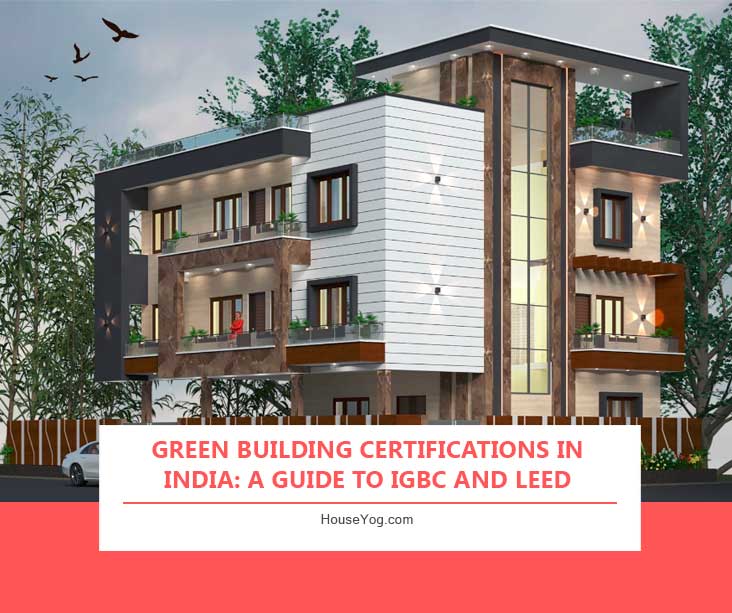Build smart, save energy, and add long-term value to your property.
With growing concerns around sustainability, more homeowners and builders in India are turning to green building certifications. These certifications not only prove your commitment to the environment but also offer practical benefits in energy savings, indoor comfort, and property value. Let’s understand what green certifications really mean and why they’re becoming essential in modern construction.
What Are Green Building Certifications and Why Do They Matter?
Green building certifications are official recognitions that a building meets specific environmental performance standards. They evaluate how resource-efficient, sustainable, and environmentally responsible a building is during construction and operation.
In India, with rising awareness of climate change and long-term cost savings, green buildings are not a luxury, they are the future.
Two Major Green Certification Bodies in India
In India, two widely recognized green certification systems dominate the landscape: IGBC and LEED. While both promote eco-friendly practices, they differ in origin, scope, cost, and approach. Here’s a quick look at how they compare and where each fits best.
1️ IGBC – Indian Green Building Council
- Backed by: Confederation of Indian Industry (CII)
- Targeted for: Homes, offices, hospitals, schools, townships, and factories
- Rating Categories: Platinum, Gold, Silver, Certified
- Focus Areas: Energy efficiency, water conservation, sustainable materials, indoor air quality, and site planning
2️ LEED – Leadership in Energy and Environmental Design
- Managed by: US Green Building Council (USGBC)
- Applicable Globally (including India)
- Rating Levels: Certified, Silver, Gold, Platinum
- Focus Areas: Carbon emissions, material reuse, energy optimization, innovation in design
IGBC vs LEED: Key Differences
Choosing between IGBC and LEED depends on your project type, budget, and sustainability goals. Let’s break down the major differences to help you decide which certification is right for your home or commercial building.
| Feature | IGBC (India) | LEED (Global) |
| Managing Body | Indian Green Building Council | US Green Building Council |
| Cost | Lower, INR-based | Higher, USD-based |
| Local Focus | Highly tailored to Indian conditions | Global standards, but adaptable |
| Language & Support | Indian-centric documentation | International processes |
| Popularity | Growing in housing projects | Widely used in premium/commercial spaces |
Verdict: For residential or semi-urban projects in India, IGBC is often more practical and cost-effective.
Benefits of Green Certification
Beyond sustainability, certified green buildings offer many functional advantages—from lower utility bills to higher market value. Here’s why investing in green certification pays off in the long run.
- Lower electricity and water bills
- Healthier indoor air quality
- Higher resale value
- Easy home loan approvals (green loans)
- Environmental contribution & carbon credit eligibility
- Brand value if you’re constructing a commercial space
How to Get a Green Building Certified in India
Whether you’re building a home, factory, or apartment, the process of getting certified is simpler than you think, especially with the right guidance. Here’s a step-by-step overview of how green certification works in India.
Step-by-Step Process:
- Hire a Green Architect or Consultant (like Houseyog 😉)
- Register your project with IGBC or LEED
- Design building to meet green benchmarks
- Submit documentation and perform audits
- Receive final certification after evaluation
You can apply for certification during the design stage or even post-construction (but with limitations).
Cost of Green Certification in India
One of the most common questions is: “Is green certification worth the cost?” Let’s break down the typical expenses involved with IGBC and LEED certifications and help you assess their long-term value.
| Certification | Cost Range |
| IGBC (Home) | ₹60,000 – ₹1,50,000 depending on project size |
| LEED (Small Projects) | ₹2.5 – ₹5 Lakhs+ |
While the initial cost seems high, most homeowners recover this through energy/water savings within 3–5 years.
Is Green Certification Right for Your Project?
Not every building needs full-fledged certification, but many projects can benefit from even basic compliance. Let’s see what type of homes and buildings are ideal for IGBC or LEED.
If you’re planning:
- A new villa, duplex, or township
- A commercial warehouse or industrial shed
- An apartment or mixed-use space
…it’s worth exploring green certification, even if only basic IGBC compliance.
Over to You
Going green isn’t just a buzzword—it’s a commitment to long-term value, savings, and better living. At Houseyog, we design buildings that balance cost-efficiency with sustainability. Want to build a sustainable, energy-efficient home or commercial building?
Talk to our certified experts at +91 75960 58808
FAQs About Green Building Certifications in India
IGBC is managed by the Indian Green Building Council and is tailored for Indian climatic and regulatory conditions. LEED, developed by the USGBC, is an international certification with broader benchmarks. IGBC is often more affordable and better suited for residential projects in India.
No, green building certification is not legally mandatory in India. However, many local bodies and builders encourage it, and some banks offer preferential loans for certified green homes.
Green certification helps reduce electricity and water consumption, improves indoor air quality, enhances property resale value, and strengthens your environmental credibility.
Yes, IGBC offers ratings for homes of all sizes, including individual houses in Tier 2 and Tier 3 cities. The process is scalable and accessible with the right architectural guidance.
The duration depends on the certification body and project complexity. On average, the IGBC certification process takes 4 to 6 months from registration to award, while LEED may take longer due to more rigorous evaluations.






